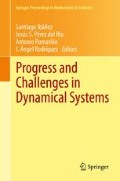Abstract
In this paper we discuss a simple model for the confinement of Saturn’s F ring and present some preliminary numerical results. The model involves the gravitational interaction of independent test particles with Saturn, including its second zonal harmonic, the shepherd moons Prometheus and Pandora, and Titan, the largest of Saturn’s satellites. We perform accurate long-time integrations (3.2 × 106 revolutions of Prometheus) to check if the particle has escaped or remains trapped in the region between the shepherds. A particle escapes if its orbit crosses the region between the shepherds, or if it displays a physical collisions (lies with Hill’s region) with them. We find a wide region of initial conditions of the test particle that remain confined. We carry out a frequency analysis and use the ratio of the standard deviation over the average main frequencies as stability index. This indicator separates clearly the set of trapped initial conditions of the test particles, displaying some localised structures for the most stable ones. Retaining only those particles which are more stable according to our indicator, we obtain a narrow elliptic ring displaying sharp edges which agrees with the nominal location of Saturn’s F ring.
Access this chapter
Tax calculation will be finalised at checkout
Purchases are for personal use only
References
Benet, L., Seligman, T.H.: Generic occurrence of rings in rotating scattering systems. Phys. Lett. A 273, 331–337 (2000)
Charnoz, S., Dones, L., Esposito, L.W., Estrada, P.R., Hedman, M.M.: Origin and evolution of Saturn’s ring system. In: Dougherty, M.K., Esposito, L.W., Krimigis, S.M. (eds.) Saturn from Cassini-Huygens, pp. 537–575. Springer, Dordrecht (2009)
Esposito, L.W.: Planetary Rings. Cambridge University Press, Cambridge (2006)
French, R.G., McGhee, C.A., Dones, L., Lissauer, J.J.: Saturn’s wayward shepherds: the peregrinations of Prometheus and Pandora. Icarus 162, 143–160 (2003)
Goldreich, P., Tremaine, S.D.: Towards a theory for the Uranian rings. Nature 277, 97–99 (1979)
Gómez, G., Mondelo, J.M., Simó, C.: A collocation method for the numerical Fourier analysis of quasiperiodic functions I: numerical tests and examples. DCDS Ser. B 14, 41–74 (2010)
Jacobson, R.A., et al.: The gravity field of the Saturnian system from satellite observations and spacecraft tracking data. Astron. J. 132, 2520 (2006)
Jorba, À., Simó, C.: On quasiperiodic perturbations of elliptic equilibrium points. SIAM J. Math. Anal. 27, 1704–1737 (1996)
Jorba, À., Villanueva, J.: On the persistence of lower dimensional invariant tori under quasi-periodic perturbations. J. Nonlinear Sci. 7, 427–473 (1997)
Jorba, À., Zou, M.: A software package for the numerical integration of ODE by means of high-order Taylor methods. Exp. Math. 14, 99–117 (2005)
Laskar, J.: The chaotic behavior of the solar system: a numerical estimate of the chaotic zones. Icarus 88, 266–291 (1992)
Laskar, J.: Introduction to frequency map analysis. In: Simó, C. (ed) Hamiltonian Systems with Three or More Degrees of Freedom. NATO Advanced Science Institutes Series C: Mathematical and Physical Sciences, vol. 533, pp. 134–150. Kluwer, Dordrecht (1999)
Merlo, O., Benet, L.: Strands and braids in narrow planetary rings: a scattering system approach. Celest. Mech. Dyn. Astron. 97, 49–72 (2007)
Murray, C.D., Beurle, K., Cooper, N.J., Evans, M.W., Williams G.A., Charnoz, S.: The determination of the structure of Saturn’s F ring by neraby moonlets. Nature 453, 739–744 (2008)
Ohtsuki, K.: Capture probability of colliding planetesimals – dynamical constraints on accretion of planets, satellites, and ring particles. Icarus 106, 228–246 (1993)
Poulet, F., Sicardy, B., Nicholson, P.D., Karkoschka, E., Caldwell, J.: Saturn’s ring-plane crossings of August and November 1995: a model for the new F-ring objects. Icarus 144, 135–148 (2000)
Seidelmann, P.K., et al.: Report of the IAU/IAG working group on cartographic coordinates and rotational elements: 2006. Celest. Mech. Dyn. Astron. 98, 155–180 (2007)
Acknowledgements
This work was initiated during LB’s sabbatical year at the Universitat de Barcelona, which was partially supported by DGAPA (UNAM) and Min. Educación (SAB2010-0123, Spain). We acknowledge financial support provided by the projects IN–110110 (DGAPA–UNAM), 79988 and 144684 (CONACyT), 334309729-9729-4-9 (Min. Ciencia e Innovación), MTM2009-09723 (Min. Ciencia e Innovación) and 2009 SGR 67 (Generalitat de Catalunya). It is a pleasure to thank Carles Simó for his encouragement, valuable comments, questions and discussions.
Author information
Authors and Affiliations
Corresponding author
Editor information
Editors and Affiliations
Rights and permissions
Copyright information
© 2013 Springer-Verlag Berlin Heidelberg
About this paper
Cite this paper
Benet, L., Jorba, À. (2013). Numerical Results on a Simple Model for the Confinement of Saturn’s F Ring. In: Ibáñez, S., Pérez del Río, J., Pumariño, A., Rodríguez, J. (eds) Progress and Challenges in Dynamical Systems. Springer Proceedings in Mathematics & Statistics, vol 54. Springer, Berlin, Heidelberg. https://doi.org/10.1007/978-3-642-38830-9_5
Download citation
DOI: https://doi.org/10.1007/978-3-642-38830-9_5
Published:
Publisher Name: Springer, Berlin, Heidelberg
Print ISBN: 978-3-642-38829-3
Online ISBN: 978-3-642-38830-9
eBook Packages: Mathematics and StatisticsMathematics and Statistics (R0)

